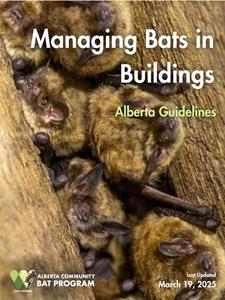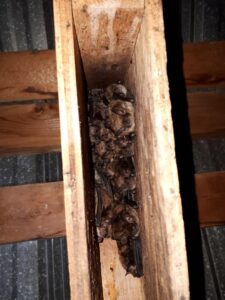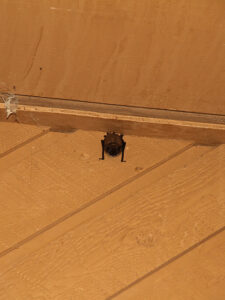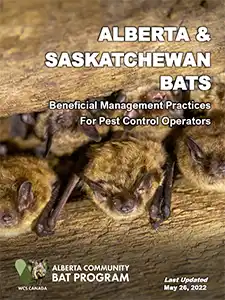Bats and Buildings
Roosts are places that bats use to rest when they are not out flying. Some of the most common bat species in Alberta use buildings as roosting sites, and as sites for raising offspring (maternity roosts). The most common building-roosting bat in Alberta is the Little Brown Myotis. This species is Endangered in Canada because of white-nose syndrome, a disease of bats caused by a fungus that people accidentally introduced to North America. Some building colonies can have 100’s or 1000’s of individuals, possibly supporting the majority of the bat population in an area extending several kilometers from where the roost is located. How we manage bats in buildings is not only important for species recovery, but can have a major impact on the health of ecosystems in the areas we live.
Be sure to visit our page on what to do if you encounter bats for important health precautions, what to do if you are bitten, and other information about relocating dead or living bats.
Want to learn more?
We have free guides with information on managing bats in buildings

Managing Bats in Buildings—Alberta Guidelines (.pdf) – Updated 2025!
Read this free guide for comprehensive information on managing bats in buildings.
Find information on how to avoid unnecessary exclusions, and if exclusions are necessary, how to minimize harm to bats.
Alberta and Saskatchewan Bats: Beneficial Management Guidelines for Pest Control Operators (.pdf)
A brochure on managing bats in buildings directed to the pest/wildlife control industry. It features an updated calendar on when it is most appropriate to exclude bats from buildings. Although this guide is directed at pest control operators, it is applicable to anyone who is managing bats in buildings.
Managing Bats in Buildings
Do you have bats living inside your home or other buildings?

In many cases, bats roosting in buildings do not need to be excluded and should be left in place. For example, colonies in old barns are often not a major concern for their owners and issues with mess can be easily resolved (such as by placing a tarp to collect waste). In other cases, it may not be viable to allow a colony to continue using a building. In cases were an exclusion cannot be avoided, there are still important steps to reduce the impact of the exclusion on bats.
Recommended steps when exclusions are necessary include:
- Watch the outside of the building for an hour starting at sunset (June or July is best). Count the number of bats exiting and make note of the exit locations. This information will help you identify areas needing repair, and to better judge the size of the colony being excluded.
- Install large multi-chambered bat houses well in advance of the exclusion (see building bat houses). Bat houses should only be used if they will remain standing, undisturbed, for the foreseeable future.
- Wait until bats leave for the winter before sealing exits or completing repairs
(November to February are generally good times for exclusions and repairs). However, bats should not be allowed to occupy the living quarters of a home, regardless of the time of year.
Bat pups cannot fly and are typically left behind while their mother feeds on insects at night. They will die if their mother is excluded from re-entering their roost during the reproductive period. Eviction during the spring prior to pups being born may still result in lower reproductive success for the colony. The best time to complete structural repairs is during the winter (November to February), when most bats leave to hibernate. However, Big Brown Bats may hibernate in buildings that are prevented from freezing (typically heated buildings), so care should be taken to ensure that bats will not be trapped inside.
Have you found bats roosting on the outside of a building or around the yard?

The best option for the bats is typically to leave them alone. They may hang around for a few days, but most will leave on their own to complete their migration. Bats roosting during the fall are often in torpor — a lowering of their body temperature to save energy. This will make bats appear slow and unable to fly, but they are usually healthy, and will warm up before leaving in the evening. If they are disturbed, they will prematurely warm up, wasting precious energy.
During mid-summer, many bats also use the outside of buildings as night roosts. These are locations they use during the night to rest and digest their meal. Often they are gone by the morning, but leave behind guano (bat poop) and urine. This mess can sometimes be contained by strategically placing a plant pot or other containment device. In some cases, a smooth surface (like plexiglass) can be attached to the wall to convince them to find another place to roost (bats cannot grip smooth surfaces). Use of patio umbrellas by bats can be discouraged by placing a cover over the umbrella before sunset, ensuring the bottoms are tightly closed (make sure there are no bats inside the umbrella before covering it). Many online shopping retailers sell patio umbrella covers.
In most cases, it is not necessary to discourage bats from using the outside portions of a home, unless there is a risk to the bat or people.
Do you need to relocate a wayward bat?
If you find a bat in the living quarters of your home, you may need to help it get safely back outside. Likewise, some bats may be outside of a home, but on the ground or in other areas within reach of people, and may need to be moved to a better location. There is no reason to harm the bat – many resources are available with instructions on how to safely relocate bats. Bats are not dangerous when left alone, but DO NOT handle bats with bare hands (thick leather gloves should be worn if handling cannot be avoided). See our page on what to do when you find a bat, for simple precautions and what to do about wayward bats. But keep in mind that if the bats are roosting outside, and are unlikely to come in contact with people, the best option is usually to leave them alone.
Useful Resources
» What To Do If You’ve Found a Bat (Bat World Sanctuary): Provides step-by-step instructions on how to remove bats from buildings, or bat found on the ground.
» Youtube video from Bat Conservation International showing removal of a bat from a building


